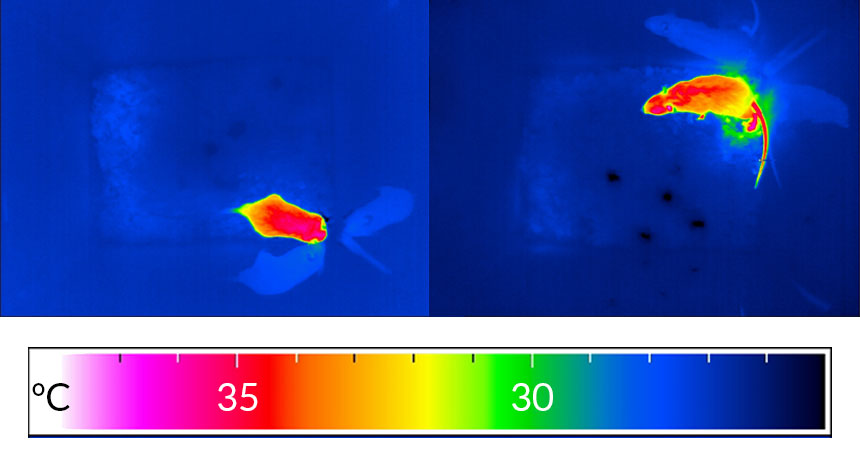Mice brains hint at how bodies keep their cool
Scientists identify a nerve-cell sensor that helps control body temperature

A mouse’s body appears warm in the left infrared image. In the right image, the mouse’s tail is shown to be heating up. The mouse is getting rid of excess heat after a certain group of nerve cells turn on.
HONG WANG AND J. SIEMENS
Certain nerve cells in a mouse’s brain may act like mini-fridges. And that’s a good thing.
These newfound “refrigerator” cells hum along in the brains, a new study in mice finds. When they turn on, they can bring the body’s temperature down dramatically — and perhaps even prevent high fevers.
The results “are totally new and very important,” says Andrej Romanovsky. He works at the Barrow Neurological Institute in Phoenix, Ariz. As a physiologist (Fis-ee-OL-oh-gizt), he studies how the body functions. Of the new findings, he says, “The implications are far-reaching.” This research reveals which cells act as a thermostat for the body.
The findings also may offer scientists new ways to explore how body temperature and metabolism are connected. Metabolism is a term scientists use to describe the chemical reactions living cells perform to keep their host alive. These reactions affect how the body uses food as fuel, and how much weight an organism carries. So the new work might reveal something about obesity — and ultimately about lifespan.
To start the study, scientists had to figure out where to scout for those so-called fridge cells. They had good reason to think they sat in a small patch of nerves in the middle of the brain. This patch of brain real estate is called the hypothalamus (Hy-poh-THAAL-uh-mus). Temperature fluctuations in a part of this tissue — the preoptic area — were known to prompt the body to return to its baseline temperature. They tell the body when to conserve heat and when to shed it. But the actual cells that served as the thermostat remained unknown. The new study uncovers their identity. They’re cells known by a protein, TRPM2, that they wear on their outer surface
Shaun Morrison is a physiologist at Oregon Health & Science University in Portland. “Overall,” he says, “this is a major discovery in the field of thermoregulation.” As the word implies, this field involves the regulation of a body’s temperature — especially the temperature at its core.
Jan Siemens, who led the new study, works at the University of Heidelberg in Germany. As a neurobiologist, he investigates the actions of nerve cells. In the new experiments, he and his colleagues looked at certain molecules. Called TRP channels, these molecules are proteins that sit on the outer layer of a cell. They help sense a variety of stimuli. What they sense can include anything from a source of pain (such as tear gas) to something cool (like menthol). The researchers ran tests on different types of these nerve cells in lab dishes. One protein seemed to respond to heat. The scientists refer to this protein as TRPM2.
Next, the researchers wanted to see what the protein did in animals. So, they gave mice fevers by injecting “heat up” molecules into their brains’ hypothalamus. Mice lacking TRPM2 became about 1 degree Celsius (1.8 degrees Fahrenheit) warmer than mice with the protein. That suggested that TRPM2 might help counter overheating.
“We like to think of it as an emergency brake,” Siemens says. It prevents a fever from getting too hot. He and his team published their findings online August 25 in Science.
Romanovsky cautions that it’s not easy to understand what to make of the fever results. Indeed, in some tests, mice without TRPM2 didn’t run hotter fevers than other mice. More experiments are needed to clarify how these nerve cells affect the risk of fever, he says.
From hot to cold
Siemens and his colleagues didn’t study only how nerve cells affect fever. They also looked at how the cells affect body cooling. To do this, the team used a genetic trick to take more direct control of cells with TRPM2 in the thermostat zone of the brain.
When these cells were prevented from firing off signals, the mice heated up slightly. And when the cells were prompted to fire off lots of signals, the mice grew downright cold. How cold? A mouse’s normal body temperature hovers around 37° C (98.6 °F). After a burst of activity from TRPM2 nerve cells, body temperatures in a mouse dropped by about 10 degrees Celsius (18 degrees Fahrenheit. And they stayed this cool for about half a day.
Recalls Siemens, seeing that “was really a ‘wow’ experience.”
The team also watched how the mice shed their body heat. For this, the researchers used an infrared — or heat — camera. When nerve cells sent out their signals to chill, the mice started dumping body heat.
The first change: Their bodies shunted warm blood to the surface of their skin. This warmed their paws and tails — body parts from which heat easily escapes. Those cameras revealed hot tails soon after the nerve cells turned on. They also revealed that the animals’ sleeping areas warmed as the mice transferred heat from their bodies to their beds. The cooling animals “were actually warming up their surroundings,” Siemens reports.
More work is needed to say whether similar cells help cool people.
For now, scientists don’t have good drugs that affect TPRM2. One day, however, these data point toward ways to induce drastic temperature drops from inside the body. Why? Doctors sometimes use ice packs and cooling blankets to chill people after they have experienced cardiac arrest (a sudden, unexpected loss of heart function, breathing and consciousness). In these cases, an internal cooldown might be more effective.
And the new research may help pave the way to do that.







